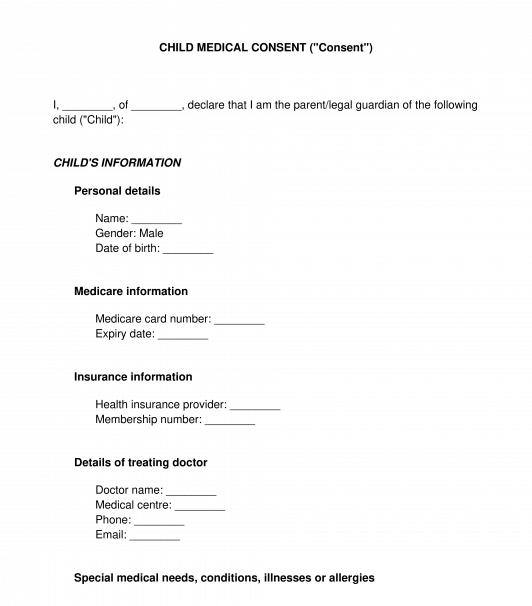 15/09/2025
15/09/2025

Answer a few questions and your document is created automatically.

Your document is ready! You will receive it in Word and PDF formats. You will be able to modify it.

 15/09/2025
15/09/2025
 Word and PDF
Word and PDF
 1 to 2 pages
1 to 2 pages
A Medical Consent Form is used when a child's parents/legal guardians are consenting to certain medical treatments on behalf of the child. This may be particularly useful in circumstances when the child is in somebody else's care for a period of time, for example if the child is going to be travelling with a sports team, school group or other youth organisation.
The consent form may be used to authorise certain medical treatments or medication to be administered to the child. It may also be used to consent to the sharing of the child's medical information or health insurance information. It can also be used to list the child's key medical information, such as medicare number, existing health conditions, allergies, medication, doctor, insurance provider and other relevant information. It may also set a time frame during which the consent will apply.
In some cases, if a child needs medical treatment while their parent(s)/guardian(s) are out of contact, then their health might be put at risk if there are delays while medical staff are waiting to be given permission to treat the child. In addition, if someone gives medical treatment to the child without the necessary consent, then there could be legal risks.
Therefore, this consent form can be used to help provide better health outcomes for the child, and to help avoid any unwanted legal consequences. It can also help to clarify all relevant information - making sure that the child's information is recorded in an easy to access place, and the parent(s)/legal guardian(s) have made a clear decision about what treatment/medication they approve for their child.
How to use this document
Use this document to provide all relevant information about the child.
Start by entering the child's relevant personal information when prompted (such as name and date of birth). Enter their health insurance information when prompted, as well as their relevant health information (such as details about any illnesses, injuries, health conditions, medication and vaccinations). If a particular person is going to be administering the treatment/medication for the child, enter the relevant details for that person (who we are referring to as the "agent" in this document). We can also limit the timeframe for which the authority will apply.
Once the relevant information has been entered, the document can be printed and signed by all relevant parties. There is an option to have the signatures witnessed, which can be a good idea to ensure that the document is accepted everywhere that the parties need to use it. Witnesses should be an adult and should be independent.
The document can then be given to the relevant people or organisations, such as doctors and insurance companies. Many parents/guardians choose to provide the document to these organisations themselves, and well before they go out of contact. This way, if the organisation has any concerns about the document or needs to speak to the parents/guardians about it, they can do so.
Applicable law
In Australia, children are generally presumed to be unable to make decisions about their health if they are under the age of 18 (or under the age of 16 in South Australia). However, depending on the specific decision that is being made, a child may be deemed competent to understand the situation and make the decision even though they have not attained the relevant age.
If a child is not competent to make a decision about their health or consent to their own medical treatment, then their parents/guardians will need to make the decision or provide consent as required.
Medical treatment of children is governed at the state/territory level in Australia and the rules vary somewhat between the different jurisdictions. In New South Wales, the Minors (Property and Contracts) Act 1970 (NSW) provides some rules regarding medical treatment of children. In South Australia, the Consent to Medical Treatment and Palliative Care Act 1995 (SA) deals with the consent of children to medical treatements in that jurisdiction. Otherwise, the medical treatment of children generally is covered by the common law. The English case of Gillick v West Norfolk & Wisbech Area Health Authority [1986] AC 112 has been applied in Australia on the issue of whether or not a child is competent to make their own medical decisions.
If in doubt, seek legal advice.
How to modify the template
You fill out a form. The document is created before your eyes as you respond to the questions.
At the end, you receive it in Word and PDF formats. You can modify it and reuse it.
Medical Consent Form for Child - sample template
Country: Australia